Spider plants (Chlorophytum comosum) are one of the most popular houseplants out there.
When it comes to indoor gardening, it’s hard to beat the spider plant where ease of care is concerned.
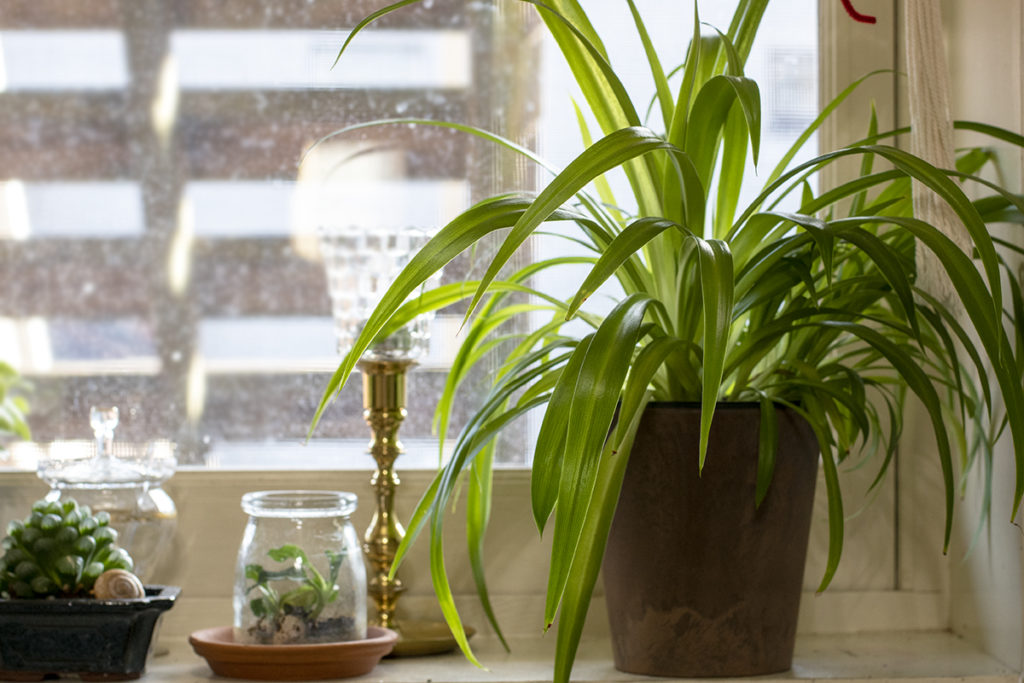
While they thrive in bright indirect sunlight, they will happily grow in low light conditions as well. These inexpensive plants don’t have special soil or fertilizing needs. Spider plants don’t need a lot of water and will bounce back if you forget about them; they are in the same family as air plants.
And as far as cleaning the air, it’s hard to beat the spider plant’s capabilities.
Their long slender leaves can be solid green or variegated with green and white stripes. There’s even a curly-leaved variety, Bonnie. It’s no wonder that nearly every plant lover has one. Or several.
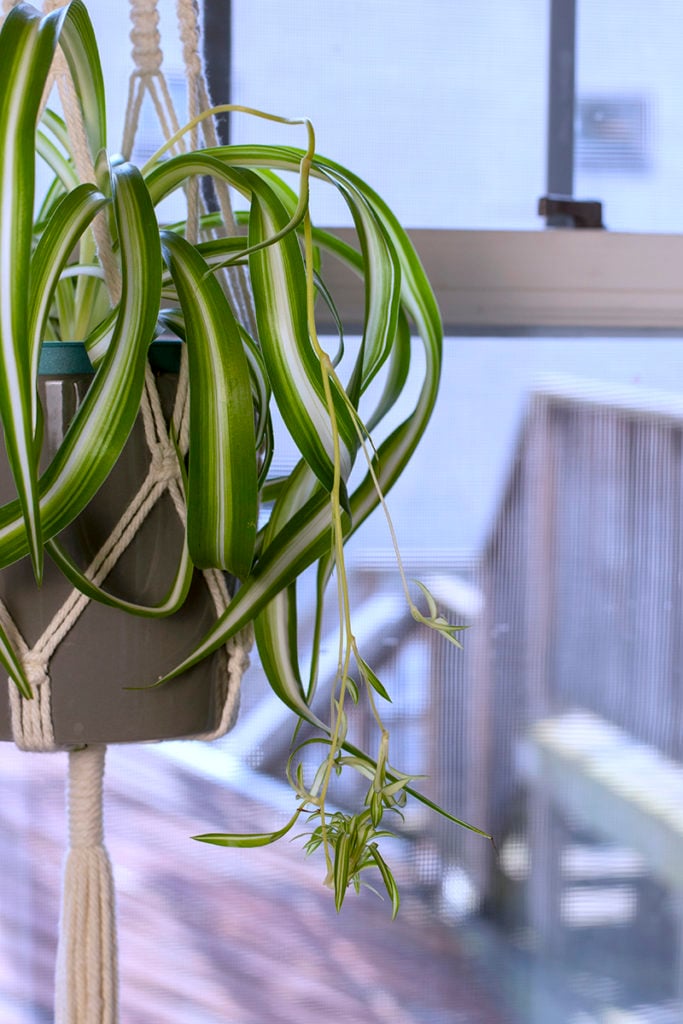
Spider plants are so popular that they’ve made it onto every one of our most popular houseplant lists.
8 Hard To Kill Houseplants – The Best Plants For Forgetful Owners
9 Low Maintenance Houseplants For The Busy Green Thumb
12 Beautiful Low-Light Houseplants
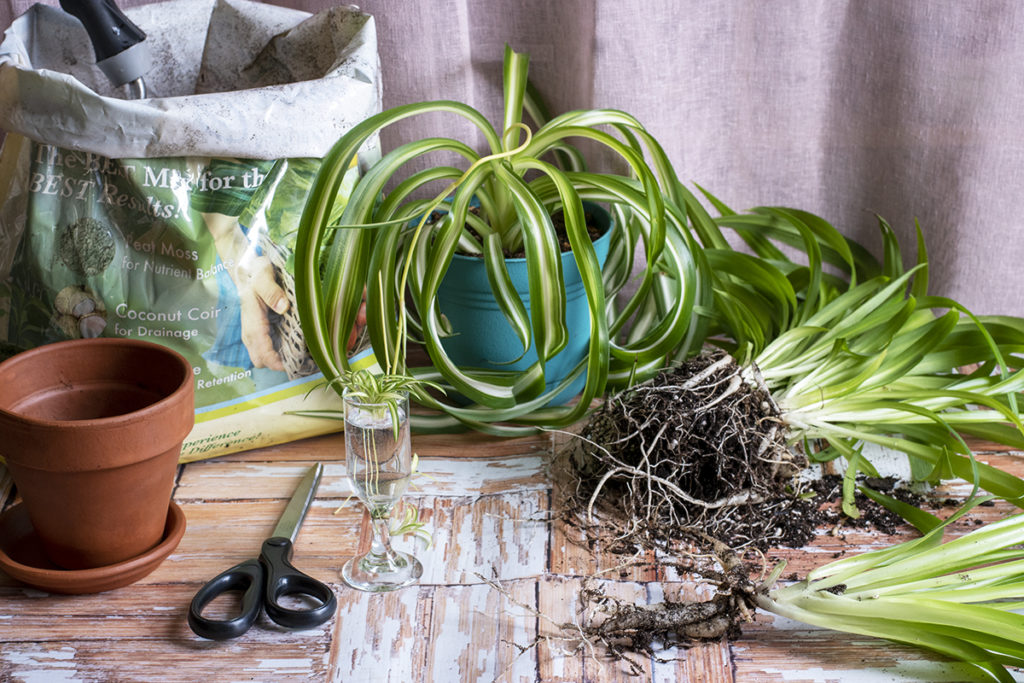
One of the best things about these plants is how easy they are to propagate. In fact, one of the simplest ways to tell if you have a healthy spider plant is whether or not it’s making babies. Happy spider plants will consistently create new offshoots of themselves. A long stem called a stolon will arch up out of the plant with a tiny new baby spider plant on the end of it – a spiderette.
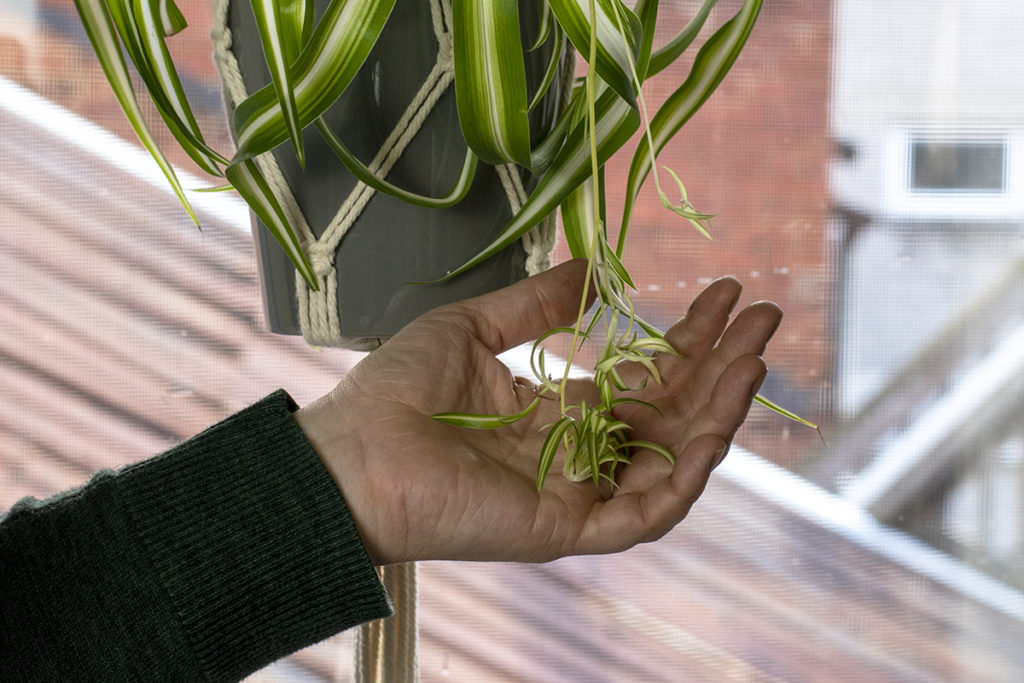
The spiderette is a perfectly formed miniature just ready to be propagated.
You can fill your house with friendly green air filters or give your friends and family an easy-care houseplant and the gift of clean air. New spider plants can be propagated both with spiderettes and without them. Let’s take a look at all the ways you can propagate spider plants.
Propagating With Spiderettes
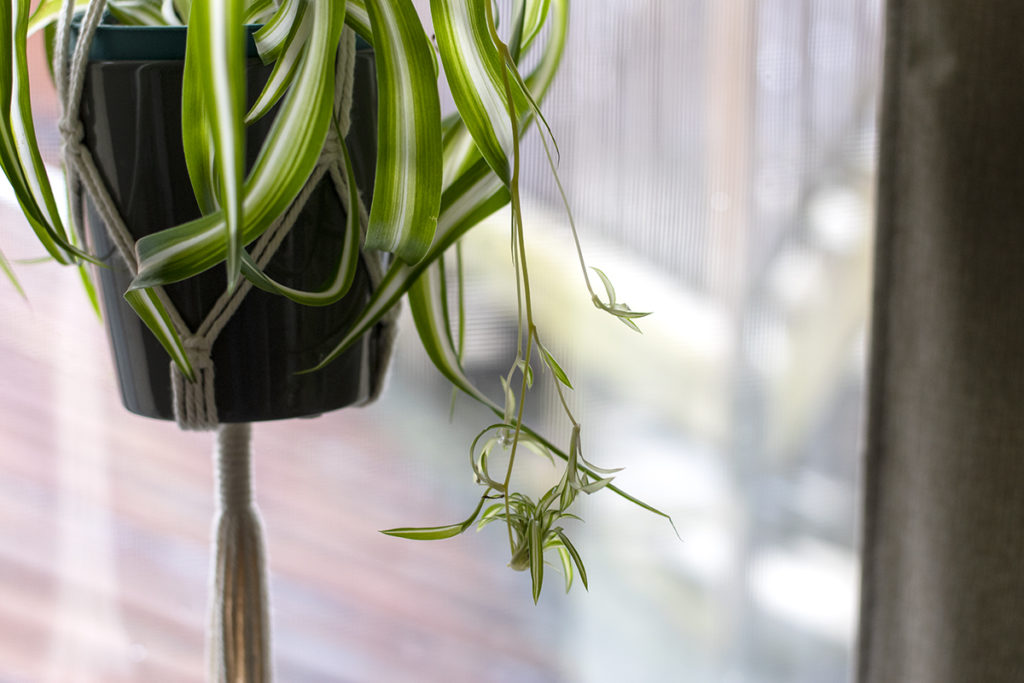
If your spider plant has put out spiderettes, it’s telling you it’s ready to take over the world. Of course, you don’t need to remove these baby spider plants. You can leave them attached, and they will continue to grow right along with the main plant, even creating spiderettes of their own.
Before you use a spiderette for propagation though, it’s important to look at the bottom. To successfully put out roots, the spiderette must have a node, a tiny nob at the very base of the leaves.
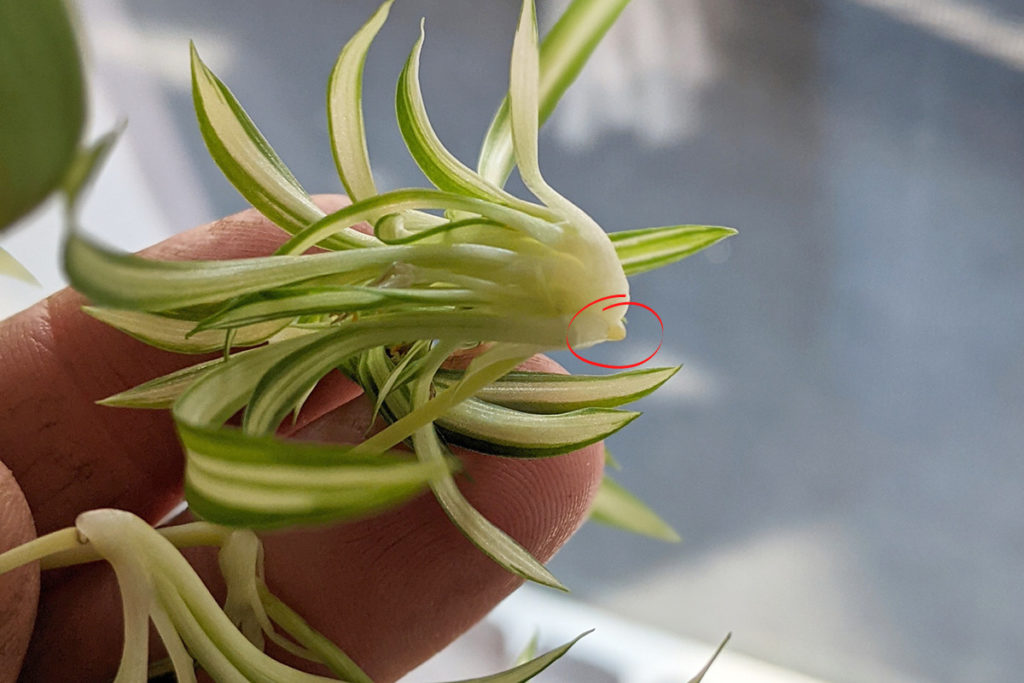
As long as your baby spider plant has a node, you’re good to go. If one hasn’t developed yet, leave it attached to the stolon until a node develops.
Cutting Spiderettes from the Stolon
For several of these propagation methods, you’ll be cutting the spiderettes from the stolon. As always, whenever you are cutting a plant, it’s important to use a sterile cutting implement. You have two choices when making your cut.
If you’re looking to encourage more spiderettes, cut the stolon as close to the base of each new spiderette as possible, leaving the majority of the stolon intact. New spiderettes will develop along the stolen.
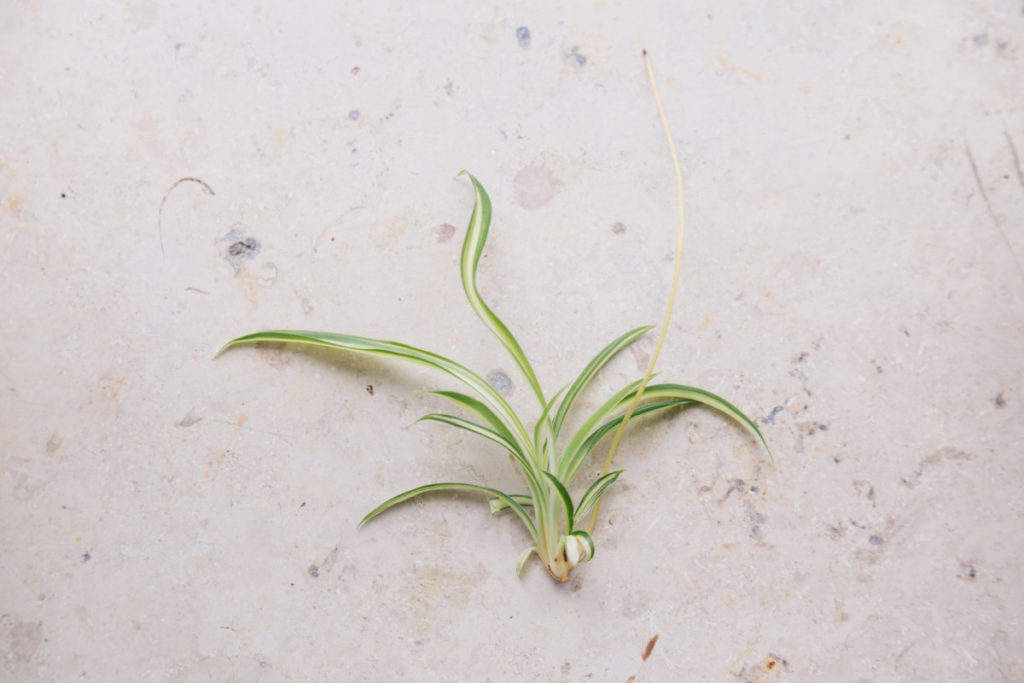
However, if you have enough spider plants and your family won’t let you in the door until you prove you aren’t smuggling in new plants, snip off the entire stolon at the base of the main plant.
Now let’s get propagating!
Propagate In the Same Pot
This is one of my favorite things to do with spiderettes, as it takes seconds and requires no equipment or tools. And I’m lazy.
Gently grasp the spiderette and press it into the soil of the main plant’s pot. You don’t even need to cut the stolon. The baby spider plant will take root over a few weeks.
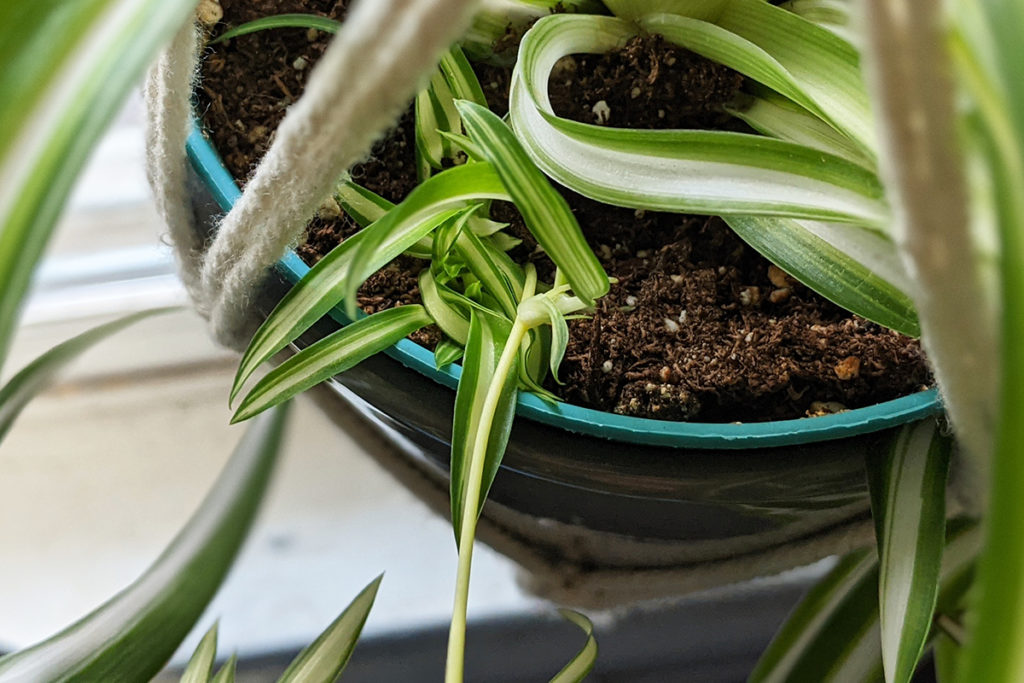
This propagation method is a great way to fill out a smaller plant, making it bushier over time. Naturally, once you do this a few times, you’ll run out of room.
Once you’ve filled your pot with new spider plants, you can do the same thing, only using a separate smaller pot of soil for each spiderette. This method requires a bit more room as you’ll need to have a place for the main plant and the smaller pots that will hold the growing spiderettes.
After a few weeks, gently wiggle the spiderette you planted. If it pulls out of the soil easily, push it back in and wait a bit longer. If you feel resistance when you wiggle it, roots have developed, and you can now snip the new plant away from the stolon. Use clean, sterilized scissors and cut the stolon as close to the base of the new plant as possible.
This propagation method allows the baby spider plants to receive nutrients from the main plant while establishing its root system. You’ll still need to water the new plant, though.
Water
Ah, water propagation. We all know that soil propagation is quicker, but there’s something immensely satisfying about watching roots develop in water. And so, for many of us, water propagation is our preferred method.
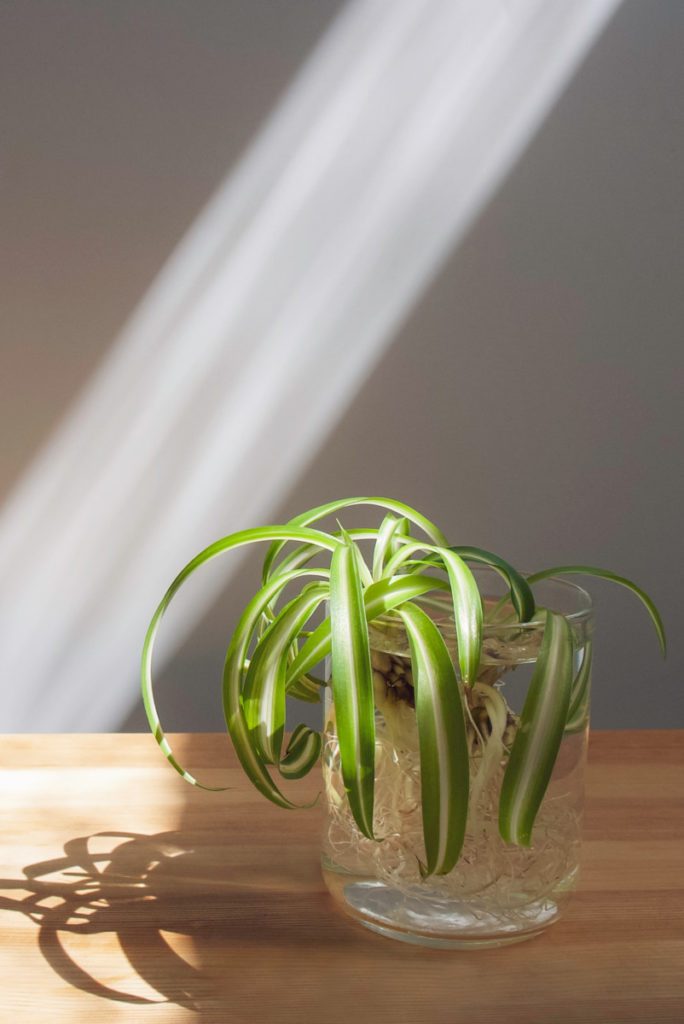
To propagate in water, you want to place the spiderette in a clear glass container that will allow only the bottom-most portion to sit in the water. You don’t want the leaves sitting in the water, or they will rot.
Place the container in a sunny location and patiently wait for the magic to happen.
You’ll need to add water periodically to make sure the bottom of the spiderette remains submerged. Replace all of the water and rinse out the container every couple of weeks or if you see any green scuzz developing.
Once the new plant has developed roots at least 2-3” long, it’s ready to be planted in soil.
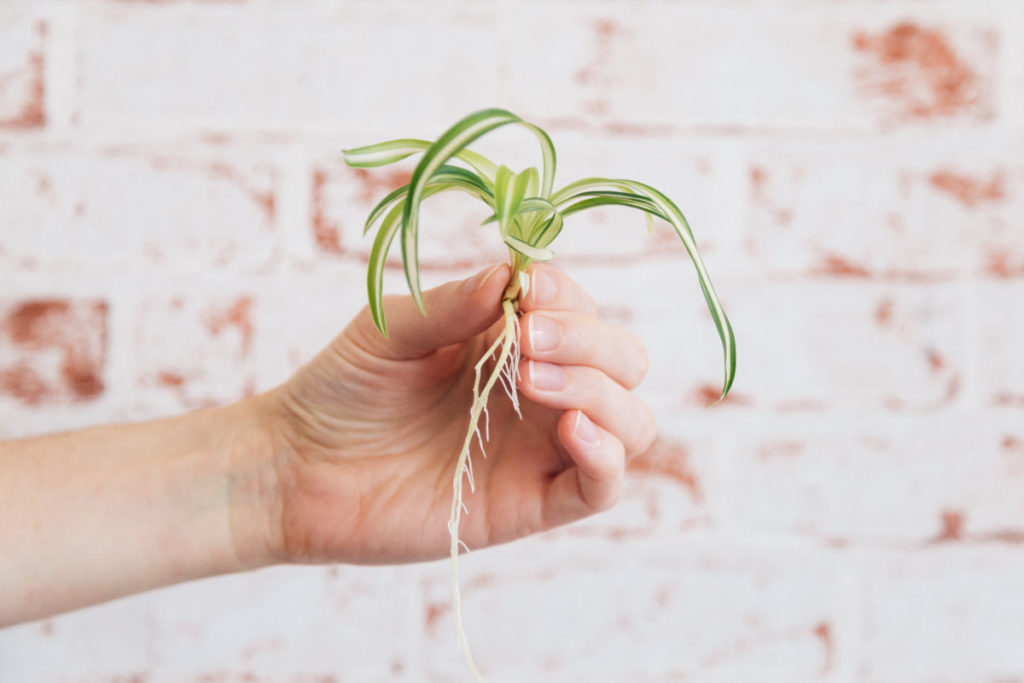
I like to use a seed-starting mix or another light soilless potting mix for new plants. Premoisten your potting mix, then use a pencil or chopstick to create a hole. Gentle wiggle the roots of your new plant down into the potting mix. Don’t submerge the plant deeper than the base of the spider plant. Gently press the potting mix around the plant and water it in.
Keep your newly potted plant where it will receive bright indirect sunlight until you know it’s settled into its new pot nicely.
Soil
Again, using a seed-starting mix, premoisten the mix in your pot of choice and use a pencil or chopstick to make a small indentation in the soil. Gently poke the spiderette into a pot of soil with the node end down. You want to cover just enough of the bottom of the baby spider plant so it remains upright without covering the leaves.
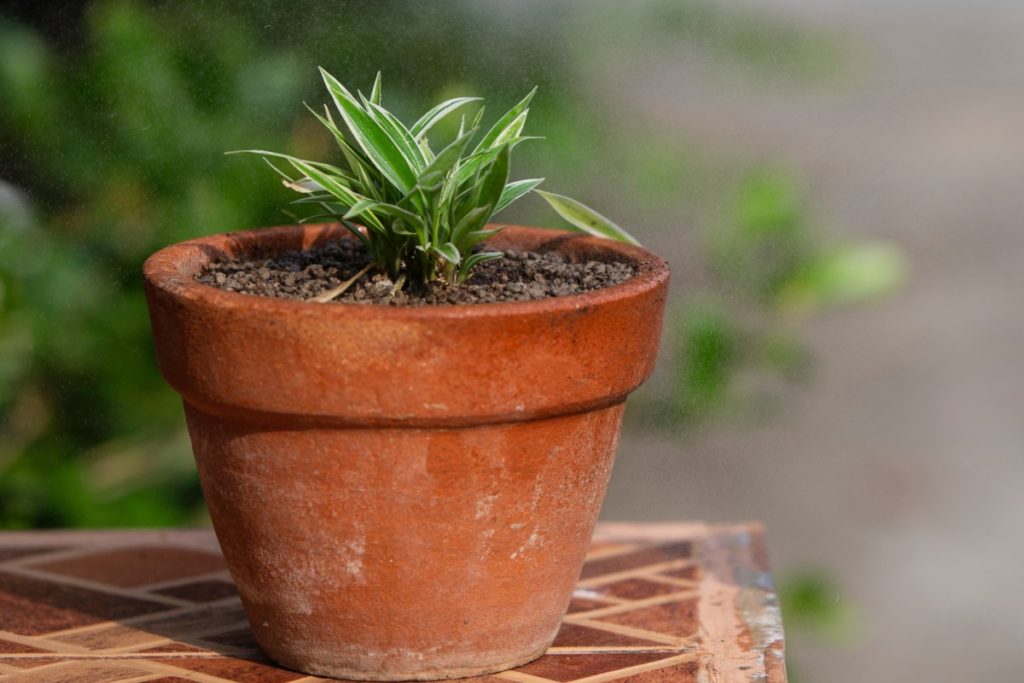
Water and place the pot in a well-lit location. After several weeks the plant will establish roots. Gently grasp the spiderette and gently pull on it; if you meet resistance, you’ve got roots! Your new spider plant is ready for gift-giving or a more permanent location.
If the spiderette pops right out of the soil with no roots, just pop it back in and wait a while longer.
Propagating Without Spiderettes
Propagation By Dividing
While many plant enthusiasts prefer propagating spider plants with super cute spiderettes, you can propagate these plants without them. Although this method is a tad messier and requires a larger, more mature plant, spider plants can be divided and put into new pots.
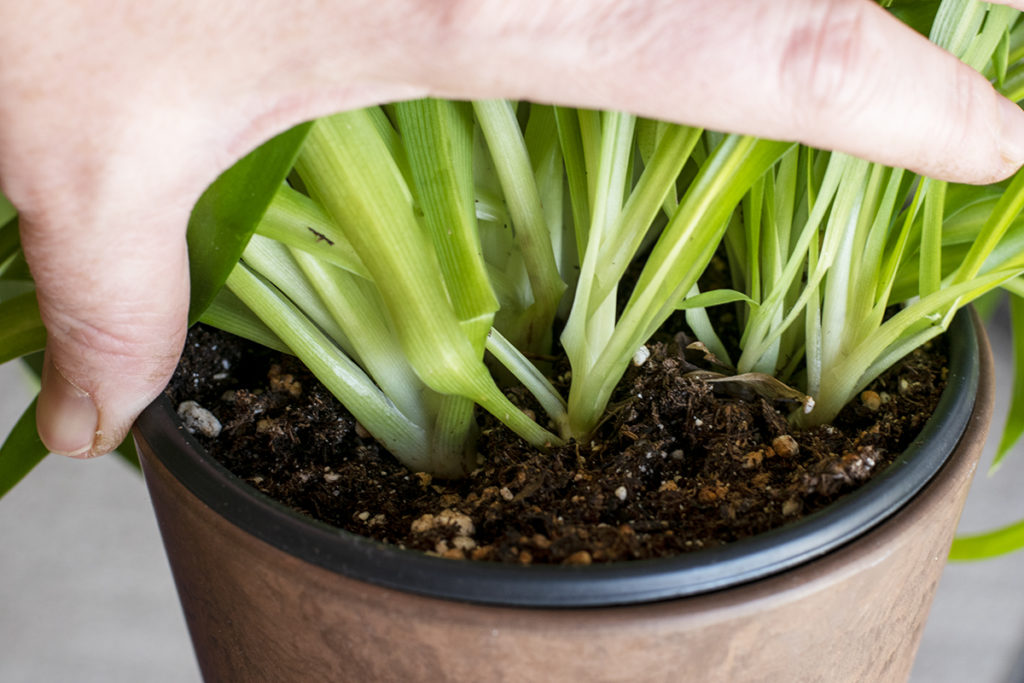
The plants grow in clusters in the soil. To propagate by division, you’ll need to remove the plant from its pot and gently brush away the soil to reveal the root system. In doing so, you’ll be able to see the natural clumps of roots at the base of the plant.
Once you’ve decided where you want to separate your plant, use a clean and sterile knife or scissors and cut these clusters apart.
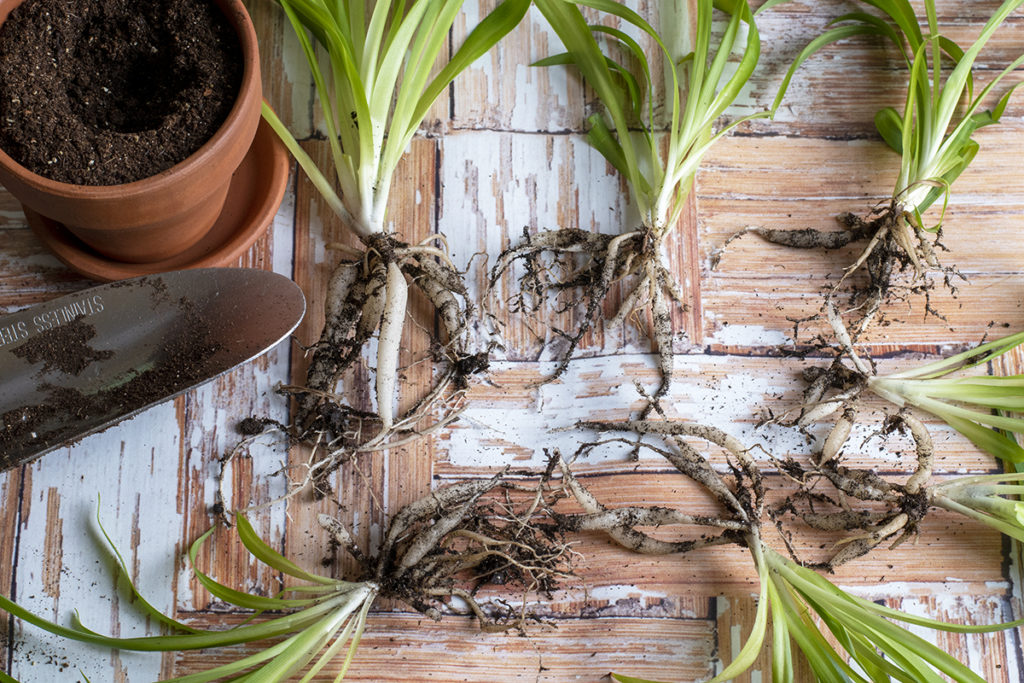
Once you’ve made all the divisions you want, it’s important to let the new clusters and the main plant scab over. If you plant these pieces immediately in soil, you’re inviting rot. There’s nothing sadder than seeing a newly potted division turn yellow and die after all of your efforts.
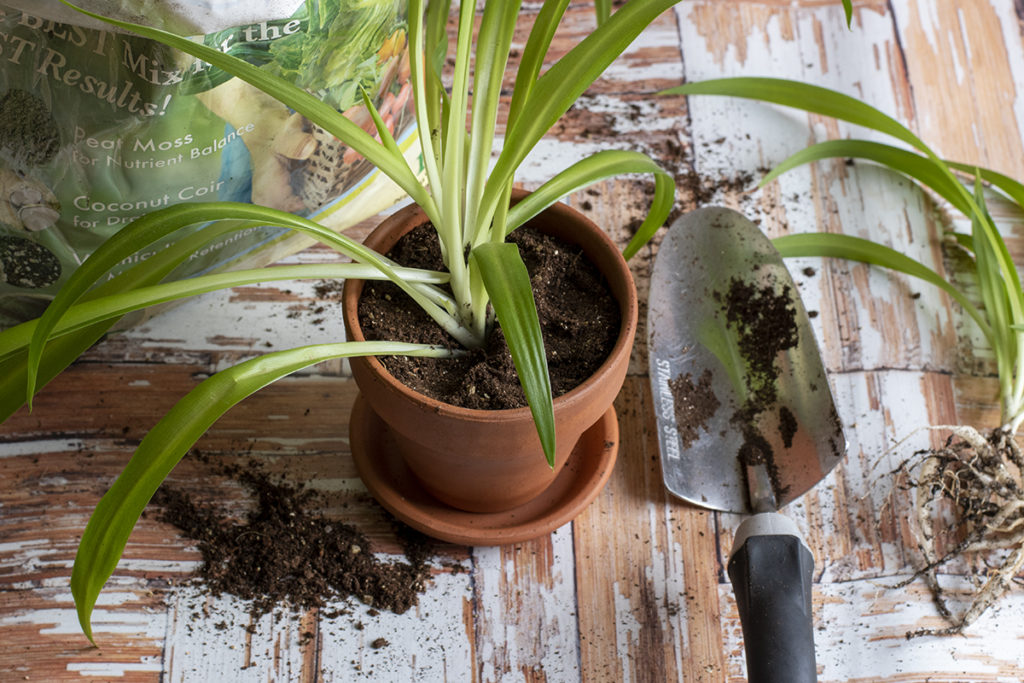
Let the cut pieces sit for a day or two and then repot each piece. Water them in and place the new plants where they will receive bright indirect sunlight. After a few weeks, your divided spider plants should be thriving, and before you know it, they will be making spiderettes of their own.
Spiderettes – Should you Remove them or Not?
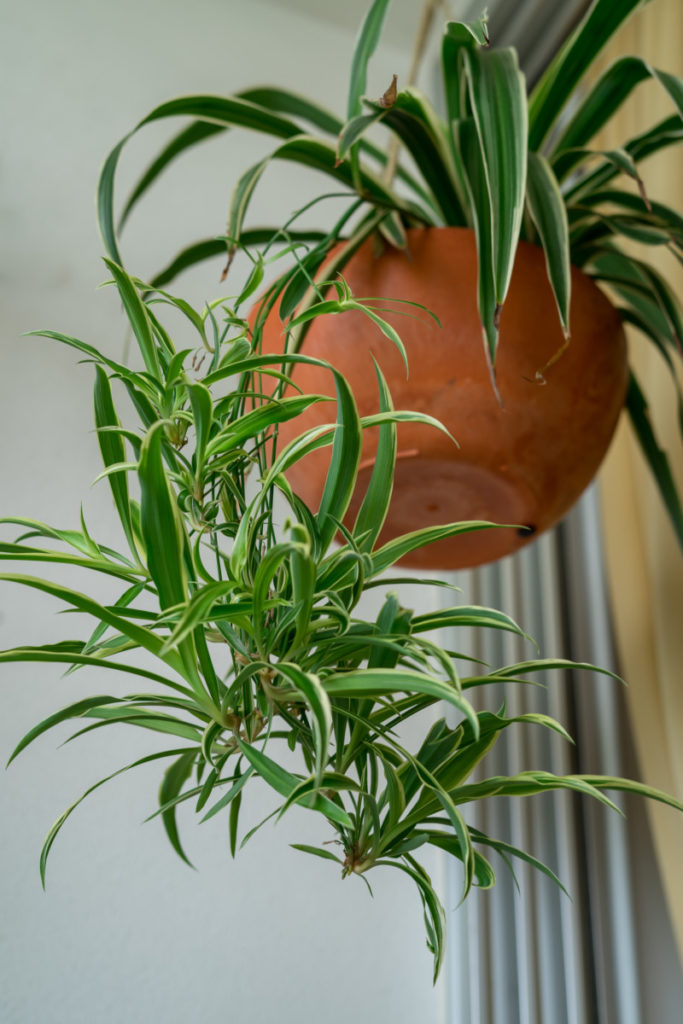
What do you do if your spider plant is putting out spiderettes and you don’t want to propagate them? You don’t have to cut off new spiderettes.
As I mentioned above, they will continue to grow along with the main plant. However, if you wish to maintain a certain size or shape, you can simply trim off these baby spider plants and compost them.
Or you can give the spiderettes to fellow plant lovers. I have yet to meet a houseplant nut who doesn’t love the thrill of watching a cutting develop roots. We’re all propagation junkies, I think.
And that’s all there is to it.
The spider plant tops the list for one of the easiest houseplants to propagate. You’ve got plenty of choices when it comes to growing new plants from your main plant.
Choose one method you prefer or give each one a try and see which gives you the best results. Before you know it, your home will be filled with lush, green plants and clean air, thanks to all of the new spider plants you’ve created.

Get the famous Rural Sprout newsletter delivered to your inbox.
Join the 50,000+ gardeners who get timely gardening tutorials, tips and tasks delivered direct to their inbox.

